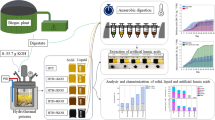Abstract
The present paper presents an experimental approach to the chemical and physical properties of the agricultural biomass from the point of view of the use of the biodegradable materials as fuel in incinerators at small and large scales. The wide variety of biomass sources implies a wide range of biomass fuel properties, both physically and chemically. Waste biomass could provide a significant part of the energy demand if appropriate conversion technologies are used. The types of agricultural biomass considered are corn, corn stalk, cereal mix, wheat, oatmeal, barley, corncob, rye, two-row barley, and corn and corncob mix. The study underlines the physical and chemical properties for analyzed materials. Using a statistical treatment to compare our set of data for different types of materials with the existing data from the literature, it can be noted that the net calorific values presented in this work are not statistically different from the mean value of the existing data in the literature. The net calorific values of the selected biomass ranged from 16,566 to 17,984 kJ kg−1 (dry basis). During the experiment, the flowing temperatures of the selected agricultural biomass were between 880 and 1480 °C. The flowing temperature values for the presented data are different than the mean values of data from references. So, the combustion facility allows the use of fuel from many local sources, thus making the control and minimization of the major part of the operational cost possible. The ash melting process is strongly influenced by its chemical composition, and it takes place in a wide temperature range. Therefore, the present work describes the characteristic points of the ash melting behavior. A complete proximate and ultimate laboratory analysis was conducted in order to determine the physical and chemical material characteristics [C, H, N, volatile matter, moisture, ash content, and gross and net calorific values (GCV and NCV, respectively)], the major and minor elements (Mg, Al, Si, P, S, Cl, K, Ca, Mn, Fe, Zn, Cr, Mn, Ni, Cu and Pb) and the ash melting points (SST, DT, HT and FT) for the analyzed materials that are further used in the combustion processes.
Similar content being viewed by others
References
Scarlat N, Martinov M, Dallemand JF. Assessment of the availability of agricultural crop residues in the European Union: potential and limitations for bioenergy use. Waste Manag. 2010;30(10):1889–97.
Demirbas MF, Balat M, Balat H. Potential contribution of biomass to the sustainable energy development. Energy Convers Manag. 2009;50(7):1746–60.
Hoogwijk M, Faaij A, Eickhout B, Vries B, Turkenburg W. Potential of biomass energy out to 2100, for four IPCC SRES land-use scenarios. Biomass Bioenergy. 2005;29:225–7.
Ciubota-Rosie C, Gavrilescu M, Macoveanu M. Biomass—an important renewable source of energy in Romania. Environ Eng Manag J. 2008;7:559–68.
Popescu F. Advantages in the use of biodiesel in an urban fleet. Case study. Major cross-roads in the Timisoara city. J Environ Prot Ecol. 2009;10(1):182–91.
Dupont C, Rougé S, Berthelot A, Da Silva Perez D, Graffin A, Labalette F, Laboubee C, Mithouard JC, Pitocchi S. Suitability of wood chips and different biomass types for use in plant of BtL production by gasification. Int J Chem React Eng. 2010. doi:10.2202/1542-6580.1949.
Cioablă AE, Trif-Tordai G, Rotaru P, Socaciu M, Ionel I. Experimental approach of co-firing and anaerobic fermentation of biomass and coal, and their thermochemical properties. J Therm Anal Calorim. 2012;110:395–403.
Yi Q, Qi F, Cheng G, Zhang Y, Xiao B, Hu Z, Liu S, Cai H, Xu S. Thermogravimetric analysis of co-combustion of biomass and biochar. J Therm Anal Calorim. 2013;112:1475–9.
Tas S, Yurum Y. Co-firing of biomass with coals – Part 2. Thermogravimetric kinetic analysis of co-combustion of fire wood with Beypazari lignite. J Therm Anal Calorim. 2012;107(1):293–8.
Baxter L. Biomass-coal cofiring: an overview of technical issues. In: Grammelis P, editor. Solid Biofuels for Energy. London: Springer; 2011. p. 43–73.
Trif-Tordai G, Ionel I. Waste biomass as alternative bio-fuel-co-firing versus direct combustion. In: Manzanera M, editor. Alternative fuel. Croatia: InTech; 2011. p. 285–306.
Zhoua C, Liu G, Cheng S, Fang T, Lam PKS. Thermochemical and trace element behavior of coal gangue, agricultural biomass and their blends during co-combustion. Bioresour Technol. 2014;166:243–51.
Carvalho L, Wopienka E, Pointner C, Lundgren J, Verma VK, Haslinger W, Schmidl C. Performance of a pellet boiler fired with agricultural fuels. Appl Energy. 2013;104:286–96.
Forbes EGA, Easson DL, Lyons GA, McRoberts WC. Physico-chemical characteristics of eight different biomass fuels and comparison of combustion and emission results in a small scale multi-fuel boiler. Energy Convers Manag. 2014;87:1162–9.
Vassileva SV, Baxter D, Andersen LK, Vassileva CG. An overview of the chemical composition of biomass. Fuel. 2010;89(5):913–33.
Sahu SG, Chakraborty N, Sarkar P. Coal-biomass co-combustion: an overview. Renew Sustain Energy Rev. 2014;39:575–86.
van Loo Sjaak, Koppejan J. The handbook of biomass combustion & co-firing. London: Earthscan Publishing House; 2007.
German Solar Energy Society (DGS) and Ecofys. Planning and installing bioenergy systems: a guide for installers, architects and engineers. London: James & James/Earthscan; 2005.
Poskrobko S. Kro´l D. Biofuels—Part II. Thermogravimetric research of dry decomposition. J Therm Anal Calorim. 2012;109:619–26.
Delcarte J, Delcarte E, Maesen P, Schenkel Y. Heavy metals, PAH and PCB emissions from short rotation crop combustion. Proceedings of the International Conference Science in Thermal and Chemical Biomass Conversion. Victoria, Canada: CPL Press; 2006; 967–974.
Konttinen J, Backman R, Hupa M, Moilanen A, Kurkela E. Trace element behavior in the fluidized bed gasification of solid recovered fuels—A thermodynamic study. Fuel. 2013;106:621–31.
Energy research Centre of the Netherlands, Phyllis2 database for biomass and waste. www.ecn.nl/phyllis2, accessed 2015.
Author information
Authors and Affiliations
Corresponding author
Rights and permissions
About this article
Cite this article
Cioablă, A.E., Pop, N., Calinoiu, D.G. et al. An experimental approach to the chemical properties and the ash melting behavior in agricultural biomass. J Therm Anal Calorim 121, 421–427 (2015). https://doi.org/10.1007/s10973-015-4710-1
Received:
Accepted:
Published:
Issue Date:
DOI: https://doi.org/10.1007/s10973-015-4710-1




